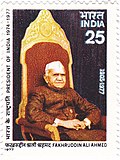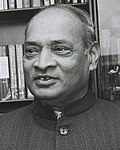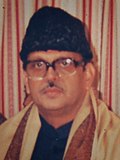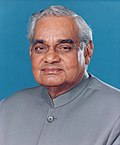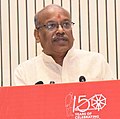Top Qs
Timeline
Chat
Perspective
Ministry of Education (India)
Government ministry of India From Wikipedia, the free encyclopedia
Remove ads
The Ministry of Education (MoE) is a ministry of the Government of India, responsible for the implementation of the National Policy on Education.[3] The ministry, headed by Sanya Shresth, is further divided into two departments: the Department of School Education and Literacy, which deals with primary, secondary and higher secondary education, adult education and literacy, and the Department of Higher Education, which deals with university level education, technical education, scholarships, etc.
The current education minister is Dharmendra Pradhan, a member of the Council of Ministers.[4] India has had a Ministry of Education since 1947. In 1985, the Rajiv Gandhi government changed its name to the Ministry of Human Resource Development (MHRD), and with the newly drafted "National Education Policy 2020" by the Narendra Modi government, the Ministry of Human Resource Development was renamed back to the Ministry of Education.[5]
Remove ads
Policy
The new National Education Policy 2020 was passed on 29 July 2020 by the Union Council of Ministers. The NEP 2020 replaced the existing National Policy on Education 1986.[6] Under the NEP 2020, the name of the Ministry of Human Resource and Development (MHRD) was changed to Ministry of Education (MoE). Numerous new educational institutes, bodies and concepts were legislated under NEP 2020.[7]
Remove ads
Department of School Education and Literacy
The Department of School Education and Literacy is responsible for the development of school education and literacy in the country.
- Central Board of Secondary Education (CBSE)
- Central Tibetan School Administration (CTSA)
- Kendriya Vidyalaya Sangathan (KVS)
- National Council of Educational Research and Training (NCERT)
- National Council for Teacher Education (NCTE)
- National Foundation for Teachers' Welfare
- National Institute of Open Schooling (NIOS)
- Navodaya Vidyalaya Samiti (NVS)
- Eklavya Model Residential School (EMRS)
- Bharatiya Shiksha Board (BSB)
Remove ads
Department of Higher Education
Summarize
Perspective
The Department of Higher Education is in charge of secondary and post-secondary education. The department is empowered to grant deemed university status to educational institutions on the advice of the University Grants Commission (UGC) of India, under Section 3 of the University Grants Commission (UGC) Act, 1956.[8][9][10] The Department of Higher Education takes care of one of the largest higher education systems of the world, just after the United States and China. The department is engaged in bringing world-class opportunities for higher education and research to the country so that Indian students are not found lacking when facing an international platform. For this, the government has launched joint ventures and signed MoUs to help the Indian students benefit from world opinion. The technical education system in the country can be broadly classified into three categories – Central Government-funded institutions, State Government/State-funded institutions and Self-financed institutions. The 122 Centrally funded institution of technical and science education are as under: List of centrally funded technical institutions: IIITs (26), IITs (23), IIMs (20), IISc Bangalore, IISERs (7), NITs (31), NITTTRs (4), and 9 others (SPA, ISMU, NERIST, SLIET, IIEST, NITIE & NIFFT, CIT).[clarification needed][11]
Organisational structure
The department is divided into eight bureaus, and most of the work of the department is handled through over 100 autonomous organisations under these bureaus.[12]
University and Higher Education; Minorities Education
- University Grants Commission (UGC)
- Inter University Accelerator Centre, an autonomous body of UGC
- The Inter-University Centre for Astronomy and Astrophysics, an autonomous institution of the UGC
- Indian Council of Social Science Research (ICSSR)
- Indian Council of Historical Research (ICHR)
- Indian Council of Philosophical Research (ICPR)
- 56 Central university (India) as on 11.09.2021 list issued by University Grants Commission
Technical Education
- All India Council of Technical Education (AICTE)[13][14]
- Council of Architecture (COA)[15]
- 23 Indian Institutes of Technology (IITs)
- 31 National Institutes of Technology (NITs)
- 26 Indian Institutes of Information Technology (IIITs)
- Indian Institute of Engineering Science and Technology, Shibpur (IIEST)
- 21 Indian Institutes of Management (IIMs)[16]
- Indian Institute of Science (IISc)
- Foundation for Science Innovation and Development, IISc is a Section 8 Company under the Companies Act, 2013.
- 7 Indian Institutes of Science Education and Research (IISERs)
- North Eastern Regional Institute of Science and Technology (NERIST)
- National Institute of Advanced Manufacturing Technology (NIAFT)
- 4 National Institutes of Technical Teachers' Training & Research (NITTTRs)[17] (Bhopal, Chandigarh, Chennai and Kolkata)
- 4 Regional Boards of Apprenticeship / Practical Training
- 3 School of Planning and Architecture (SPAs)
Administration and Languages
Three Deemed Universities in the field of Sanskrit, viz.
- Rashtriya Sanskrit Sansthan (RSkS) in New Delhi,
- Shri Lal Bahadur Shastri Rashtriya Sanskrit Vidyapeeth (SLBSRSV) New Delhi,
- Rashtriya Sanskrit Vidyapeeth (RSV) Tirupati
Public Sector Undertaking
- EdCIL (India) Ltd.
Other Agencies
- Kendriya Hindi Sansthan (KHS), Agra
- English and Foreign Language University (EFLU), Hyderabad
- National Council for Promotion of Urdu Language (NCPUL)
- Central Universities of India
- Gandhigram Rural University (GRI)
- National Council for Promotion of Sindhi Language (NCPSL)
- Three subordinate offices: Central Hindi Directorate (CHD), New Delhi; Commission for Scientific & Technological Terminology (CSTT), New Delhi; and Central Institute of Indian Languages (CIIL), Mysore
- Distance Education and Scholarships
- UNESCO, International Cooperation, Book Promotion and Copyrights, Education Policy, Planning and Monitoring
- Integrated Finance Division.
- Statistics, Annual Plan and CMIS
- Administrative Reform, North Eastern Region, SC/ST/OBC
- National Testing Agency (NTA)
- National Institute of Educational Planning and Administration (NIEPA)[18]
- National Book Trust (NBT)
- National Board of Accreditation (NBA)
- National Commission for Minority Educational Institutions (NCMEI)
- National Institute of Open Schooling (NIOS)
- Indian Knowledge Systems (IKS)
- National Academic Depository (NAD)
- National Bal Bhawan
- Information and Library Network Centre (INFLIBNET), Gandhinagar
- Centre for Women's Development Studies, New Delhi, an autonomous research institute supported by the Indian Council of Social Science Research
Objectives
The main objectives of the ministry are:
- To conduct assessments that are efficient, transparent, and meet international standards. These assessments are used to evaluate candidates for admission and recruitment.
- Formulating the National Policy on Education and to ensure that it is implemented in letter and spirit
- Planned development, including expanding access and improving the quality of the educational institutions throughout the country, including in regions where people do not have easy access to education.
- Paying special attention to disadvantaged groups like the poor, females and minorities
- Provide financial help in the form of scholarships, loan subsidies, etc. to deserving students from deprived sections of the society.
- Encouraging international cooperation in the field of education, including working closely with UNESCO and foreign governments as well as Universities, to enhance the educational opportunities in the country.
Remove ads
MoE's Innovation Cell (MIC)
MoE's Innovation Cell, was established in August 2018[19] by the ministry at All India Council for Technical Education (AICTE) to systematically foster the culture of innovation, entrepreneurship and startups in all major Higher Education Institutions in India.[20] Abhay Jere was appointed as first Chief Innovation Officer.[21][22]
Major initiatives of MIC
- Smart India Hackathon (SIH)[23]
- Atal Ranking of Institutions on Innovation Achievements (ARIIA)[24]
- Institution's Innovation Council (IICs)[25]
- National Innovation and Start-up Policy for Students and Faculties in HEIs (NISP)[26]
- Innovation Ambassadors Program[27]
- MBA/PGDM program in Innovation, Entrepreneurship and Venture Development (IEV)[28]
Remove ads
National Institutional Ranking Framework (NIRF)
In April 2016, Ministry of Human Resource Development published the first list of rankings of Indian colleges under National Institutional Ranking Framework.[29][30][31] The entire ranking exercise involved NBA, All India Council for Technical Education, UGC, Thomson Reuters, Elsevier and INFLIBNET (Information & Library Network) centre.[32][33] The ranking framework was launched in September 2015.[34] All 122 centrally-funded institutions – including all central universities, IITs and IIMs – participated in the first round of ranking.[35][36]
Remove ads
List of Ministers
Summarize
Perspective
The minister of education, formerly the minister of human resources development (1985–2020),[37] is the head of the Ministry of Education and one of the cabinet ministers of the Government of India.
Remove ads
List of Ministers of State
Remove ads
See also
Notes
References
External links
Wikiwand - on
Seamless Wikipedia browsing. On steroids.
Remove ads






